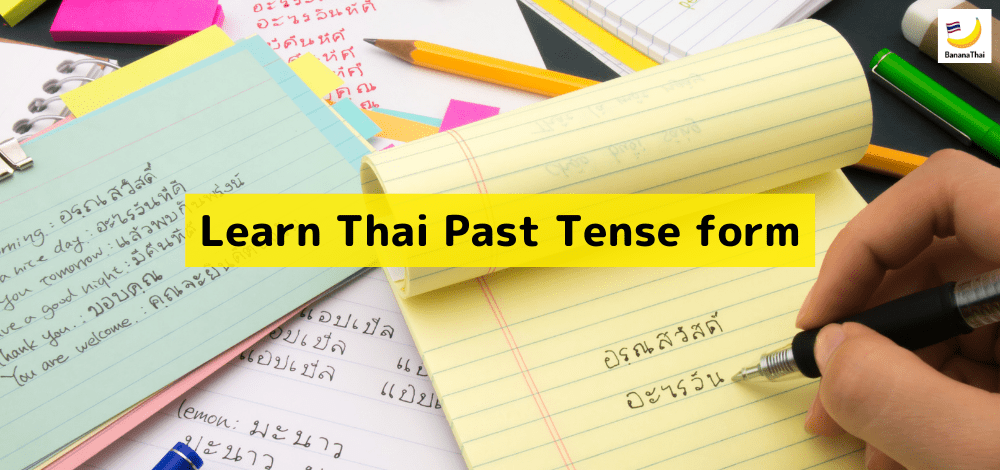
Thai Past Tense อดีตกาล – Tell a story in the past
By Kru Smuk | Situational Thai, Thai Foundation | No CommentsWho said Thai doesn’t have tenses? That’s not true. We do have tenses like in English but do not have conjugation to indicate the tense, instead, we use Tense particles (words put into a sentence to indicate tense). In this blog post, I will teach you how to make sentences in Past Tense effortlessly. Let’s dive into it.
Content Overview
Tense indicators
In English, we use the conjugation of verbs to indicate tenses.
For example
– I “go” to school. (present simple tense)
– I “went” to school (past simple tense)
However, in Thai, we do not conjugate the verb form. It never changes. Instead, we do have a few words to put in the sentence and it will be understood as this already happened in the past.
Adverbs of time (for the past)
You can indicate the past tense by putting an adverb of time-related to the past. Let’s see some examples:
| เมื่อวานนี้ | mêuua waan née | yesterday |
| เมื่อกี้ | mêuua-gêe | just now |
| เมื่อก่อน | mêuua gòn | before |
| ในอดีต | nai à-dèet | in the past |
| อาทิตย์ที่แล้ว | aa-tít têe láew | last week |
| เดือนที่แล้ว | deuuan têe láew | last month |
| ปีที่แล้ว | bpee têe láew | last year |
Once you put this word at the beginning or at the end of the sentence, this sentence turns out to be in the past form.
For examples
– ฉันกินผัดไทย chăn gin pàt tai) = I eat Pad Thai.
– เมื่อวานนี้ฉันกินผัดไทย (mêuua waan née chăn gin pàt tai) = I ate Pad Thai yesterday.
– ฉันทำงานที่ประเทศไทย (chăn tam ngaan têe bprà-têt tai) = I work in Thailand
– ปีที่แล้วฉันทำงานที่ประเทศไทย (bpee têe láew chăn tam ngaan têe bprà-têt tai) = I worked in Thailand last year.
มา maa (When something happened somewhere else)
This is one of the most common past tense forms we use in daily. Basically, we put the tense indicating particle มา (maa) at the end of the sentence.
This form of the past tense is to tell what happened somewhere in the past, while the speaker is now in a different location in the present.
– ฉันไปภูเก็ตมา (chăn bpai poo-gèt maa) = I went to Phuket.
– ฉันกินข้าวที่ร้านญี่ปุ่นมา (chăn gin kâao têe ráan yêe-bpùn maa) = I ate at a Japanese restaurant.
– ฉันขับรถไปซื้อของมา (chăn kàp rót bpai séu kŏng maa) = I drove to buy something.
– ฉันบินไปฝรั่งเศษอาทิตย์ที่แล้วมา (chăn bin bpai fà-ràng sèt aa-tít têe láew maa) = I flew to France last week.
If you observe these examples close, you will see that many times, the verbs include movement such as ไป (bpai) = to go, ขับรถ (kàb-rót) = to drive, etc. Of course, you can also use other verbs as well in this form.
ได้ dâi (When something is completed, finished, ended)
This form is commonly used when you want to highlight an action that has already been completed, finished, or done. There are two past words in this form. ได้ (dâi) implies “I got a chance to …” and the word แล้ว (láew) means “already”.
For examples
– ฉันได้เจอจอห์นแล้วเมื่อวานนี้ (chăn dâai jer jon láew mêuua waan née) = I already met John yesterday.
– คุณได้ไปซื้อของมาแล้วใช่ไหม (kun dâai bpai séu kŏng maa láew châi măi) = Did you go to shop already, right?
– ฉันทำงานเสร็จแล้ว (chăn tam ngaan sèt láew) = I finished work already.
Please note that either indicating word can be obsolete or skipped.
When the verb is not visually with motions or action
For verbs with non-action that one can visually see, we do not need to put an indicator. We usually understood it from the context.
| คิด | kít | to think |
| รู้สึก | róo-sèuk | to feel |
| รัก | rák | to love |
| ชอบ | cháawp | to like |
| เห็น | hěn | to see |
| เป็น | bpen | to be |
| เข้าใจ | kâo-jai | to understand |
| อยู่ | yùu | to be (located) |
These words can be used in both presents tense and past tense without any other indicators needed.
For examples:
– ฉันคิดว่าเขาสวย (chǎn kít-wâa kǎo sǔay) = I think/thought she is/was beautiful.
– ฉันอยู่ที่ลอนดอน (chǎn yùu tîi London) = I am/was in London.
– เขาเป็นคนดี (kǎo bpen kon-dii) = He is/was a good person.
Negative form
To build a negative sentence in the past form, you always need to add a negative particle “ไม่ได้” (mâi-dâi) before the verb.
For examples
– ฉันไม่ได้ไปภูเก็ต (chǎn mâi-dâi bpai Phuket) = I did not go to Phuket.
– ฉันไม่ได้ไปทำงาน = I did not go to work.
– เขาไม่ได้คิดว่าเขาสวย = I did not think that she is beautiful.
Telling a story
To tell a story that happened in the past, you only need to start with the first sentence in the past with the indicators mentioned above, the following sentences can be without a tense indicator as long as it’s still related to the first sentence.
Example story
เมื่อวานนี้ฉันไปกินข้าวที่ร้านอาหารญี่ปุ่นมา อาหารที่นั่นอร่อยมาก ฉันเลยโทรหาเพื่อนให้มากินด้วยกัน
(mêuua waan née chăn bpai gin kâao têe ráan aa-hăan yêe-bpùn maa · aa-hăan têe nân à-ròi mâak · chăn loiie toh hăa pêuuan hâi maa gin dûuay gan)
Yesterday I went to eat at a Japanese restaurant. The food there was very delicious, so I called my friends to join me.
Learn More
If you’d like to continue learning this topic of past tense in Thai, I made an episode on my Thai Podcast Channel on Spotify and YouTube. Please feel free to listen and enjoy learning with me.
https://anchor.fm/bananathai/episodes/EP-30-Build-a-Thai-sentence-in-past-tense-e11k45m
Summary
Unlike English, Thai does not have conjugation of verbs even for tense. We do have tense indicators in the forms of adverbs as well as particles (fill words).
If you want to learn more about Thai tenses or any fundamental topics of conversational Thai and foundation. Check out the Intensive Thai course. It’s the best online Thai course to get started.









